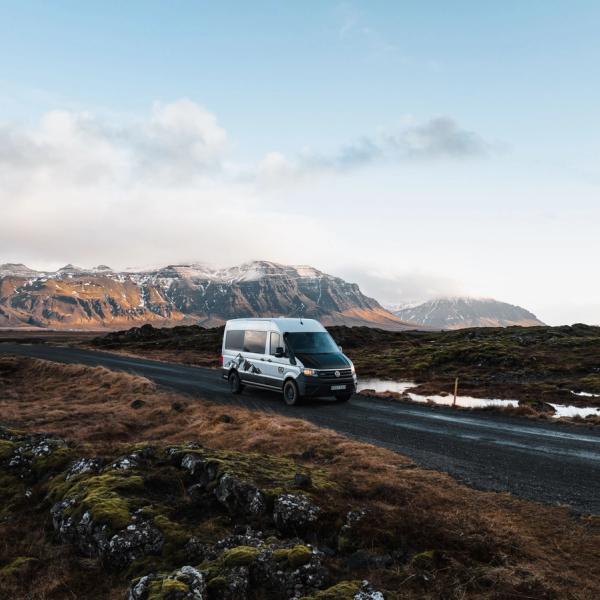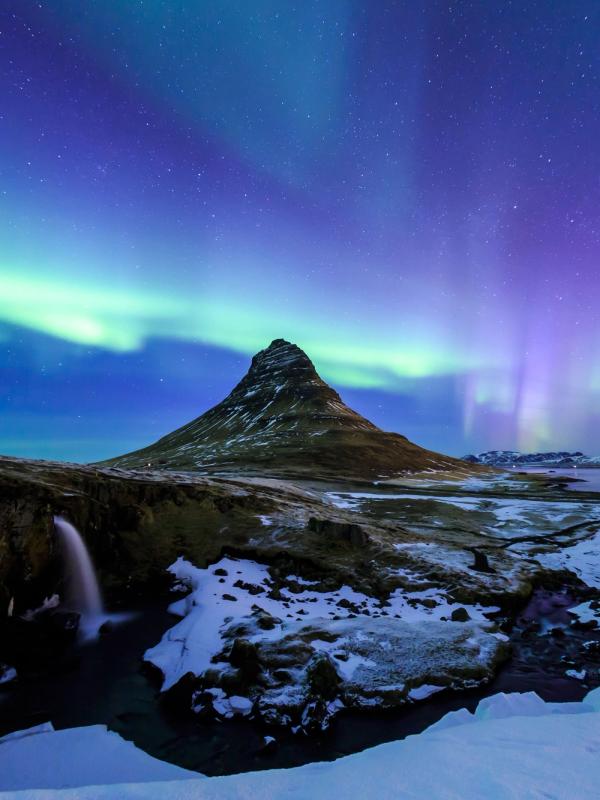
Snæfellsnes Peninsula Guide: Best Attractions, Itinerary & Travel Tips
Planning a road trip around the Snæfellsnes Peninsula? Here’s everything you need to know about this spectacular region in Iceland.
What's Snæfellsnes?
The Snæfellsnes Peninsula is Iceland in miniature – a compact region where you can experience glaciers, volcanoes, black sand beaches, lava fields, and waterfalls, all within a few hours’ drive from Reykjavik. For those wanting to experience Iceland’s wild landscapes without committing to the full Ring Road, Snæfellsnes is the perfect alternative.
Dominating the peninsula is the famed Snæfellsjökull Glacier sitting atop an ancient volcano, the heart of Snæfellsjökull National Park. Not far away, Kirkjufell Mountain – Iceland’s most photographed peak – rises dramatically from the coastline. Beyond these icons, the peninsula is filled with waterfalls, towering cliffs and lava fields, and windswept beaches.
In this guide, we’ll cover what to see, when to visit, and where to stay, along with practical tips to make the most of your trip.
The Best Attractions in Snæfellsnes
Snæfellsnes has everything that makes Iceland’s landscapes so stunning. There are two vast fjords on either side of the peninsula, waterfalls rushing down from the mountains that separate the north and south coast, and a volcano-glacier combination behind some truly spectacular landscapes and cliff formations at the very tip. Here’s what to see on a road trip around Snæfellsnes.
Eldborg Crater
Driving from Reykjavik, the first major stop on Snæfellsnes is Eldborg Crater. This near-perfect volcanic cone rises dramatically from the surrounding lava fields at the western edge of the peninsula, once the site of explosive eruptions that shaped the landscape.
A well-marked hiking trail leads to the rim, where you’ll be rewarded with sweeping views of the peninsula and a glimpse into the crater’s depths. The hike takes about an hour each way, with a steady incline but nothing too strenuous.
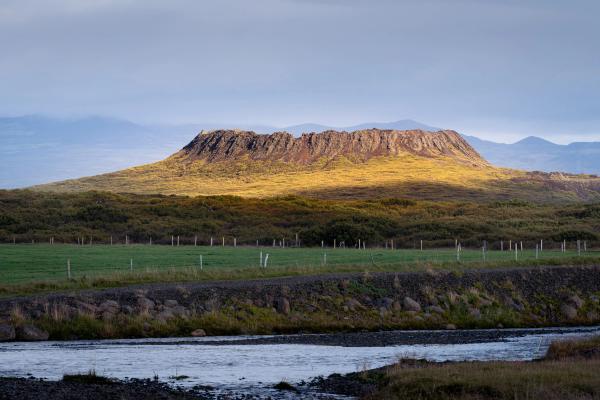
Ytri Tunga Beach
Continuing west along the southern coast, Ytri Tunga is a windswept golden-sand beach overlooking the fjord, home to a colony of grey seals. It’s a gorgeous, windswept place overlooking the vast fjord to the south.
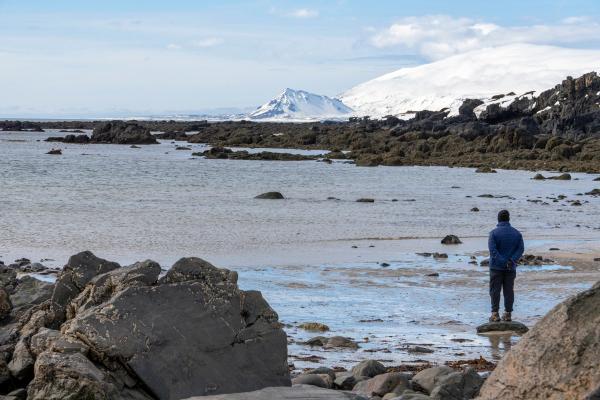
Búðakirkja
As you get closer to the Snæfellsjökull National Park, a quick detour off the main route takes you to one of Iceland’s most iconic churches, Búðakirkja. This tiny black wooden chapel stands in stark contrast to the sweeping lava fields around it. Originally built in the 19th century, Búðakirkja is a favorite subject for photographers, especially with its stark black silhouette contrasting against stormy skies or the glacier’s icy expanse.
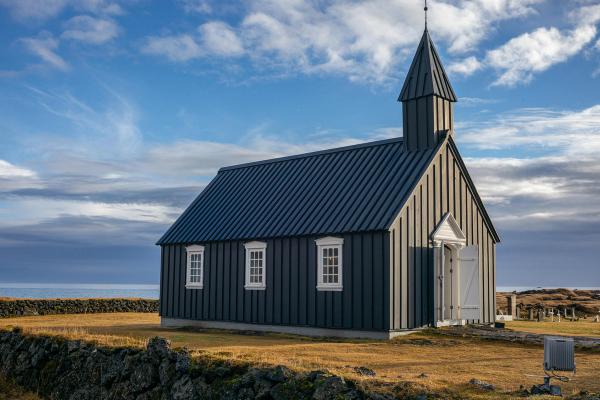
Rauðfeldsgjá Gorge
Back on the main route and closer to the glacier, Rauðfeldsgjá Gorge is a narrow ravine that cuts into the mountainside, offering a unique hiking experience. A short scramble inside the ravine and along the riverbed, aided by chains hanging from the wall, leads to a secret waterfall at the end. According to Icelandic sagas, the gorge is named after a boy who was thrown into it as punishment – just one of many legendary tales tied to this region.
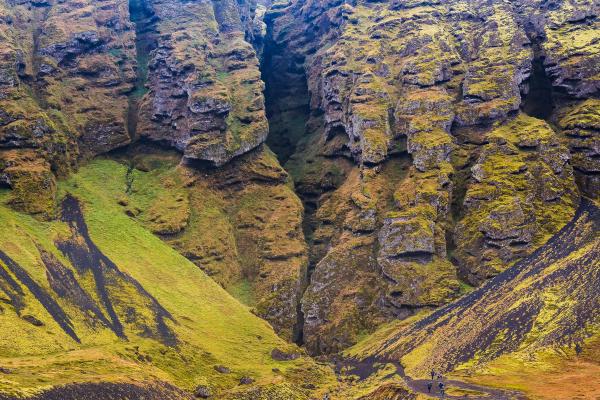
Arnarstapi Cliffs
At the very edge of the national park, the tiny village of Arnarstapi is home to some of Snæfellsnes’ most dramatic coastal scenery. Towering basalt cliffs plunge into the sea, natural stone arches frame the crashing waves, and seabirds wheel overhead. The Arnarstapi to Hellnar hiking trail offers a scenic and easy walk along the coastline, passing by lava formations and a striking stone monument to the half-troll Bárður Snæfellsás.
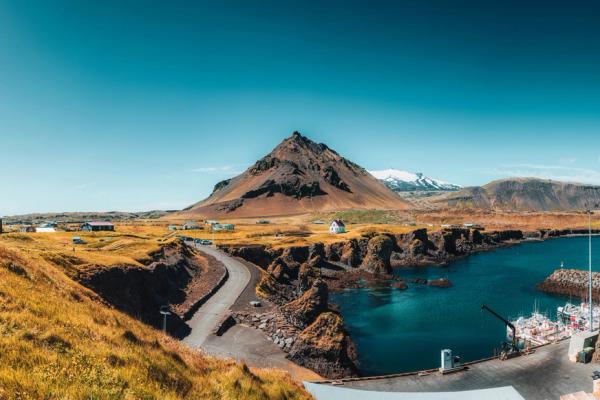
Lóndrangar Cliffs
Enter the southern side of the Snæfellsjökull National Park and the first major stop is at the towering basalt sea stacks known as Lóndrangar. Resembling the ruins of an ancient castle rising from the ocean, the sea stacks were formed by volcanic activity from Snæfellsjökull. It’s a prime nesting site for seabirds in the summer as well, who wheel around the epic cliffs you can see from the viewing platform.
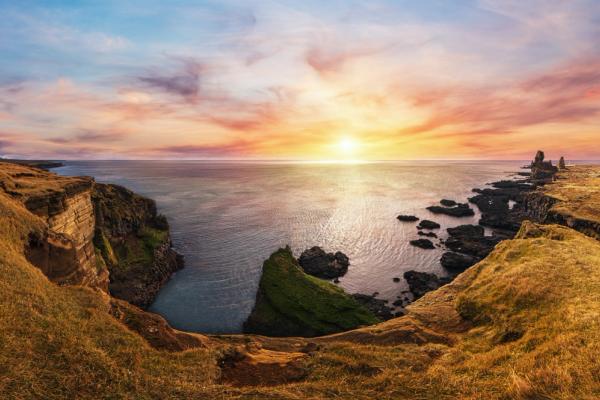
Vatnshellir Cave
Just up the road from Lóndrangar is one of the peninsula’s most fascinating activities – the Vatnshellir Cave. Here, you can join a tour and descend into the depths of a 8,000-year-old lava tube within Snæfellsjökull National Park. A spiral staircase leads you 115 feet (35 meters) below the surface, where eerie rock formations, twisting tunnels, and glistening mineral deposits reveal the raw power of past eruptions.
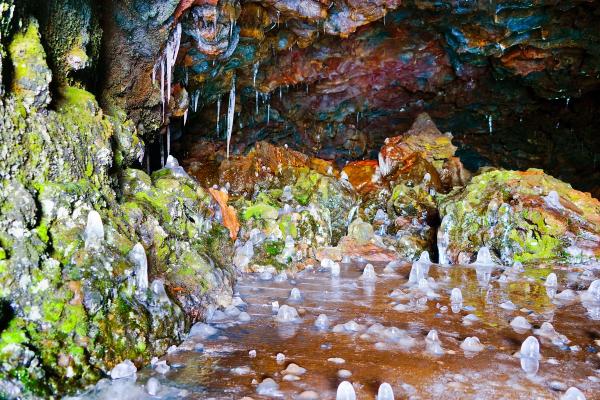
Djúpalónssandur Beach
This striking black sand beach, just a short detour from the main route, is littered with the rusted remains of a British trawler wreck. The twisted cliffs and lava fields that surround the area add a wild, rugged atmosphere to the beach. For a challenge, head to nearby Dritvík Beach and try the lifting stones once used by fishermen to prove their strength.
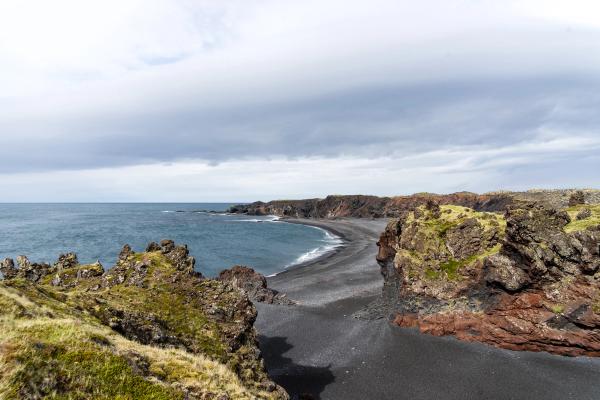
Saxhóll Crater
As you drive north, the landscapes become even more dramatic, the northwestern section pocked with craters big and small cut into the old lava. A clear view of the glacier is something to cherish – often, it’s wreathed in clouds. For panoramic views, there’s a short but rewarding climb up Saxhóll Crater, taking in the surrounding lava fields and coastline.
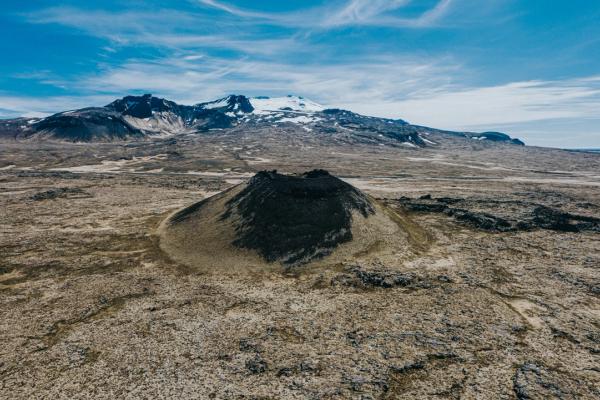
Skarðsvík Beach
A final detour off the main road through the national park takes you to the far west corner of the peninsula, where the golden sands of Skarðsvík Beach sit in striking contrast to the other black-sand beaches that ring the coastline in this region. Surrounded by rugged lava fields, this secluded cove feels otherworldly, with waves crashing against the shore and jagged volcanic cliffs framing the beach.
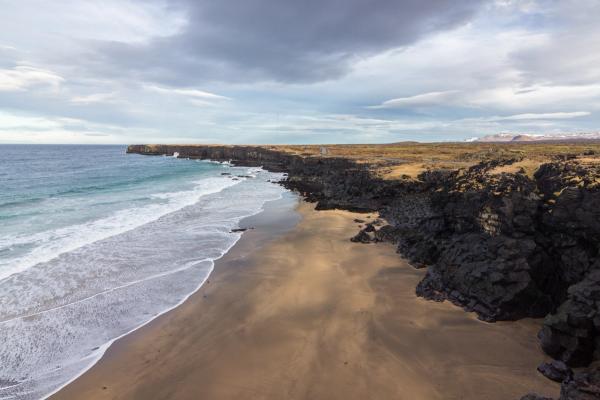
Svörtuloft Lighthouse
From the beach, a rough dirt track leads you deeper into this remote area. After a rattling drive, Svörtuloft reveals itself at the edge of the coast, a striking orange lighthouse perched on the edge of jet-black cliffs. The journey here can be long, but the dramatic stone arches and crashing waves make it worth the drive.
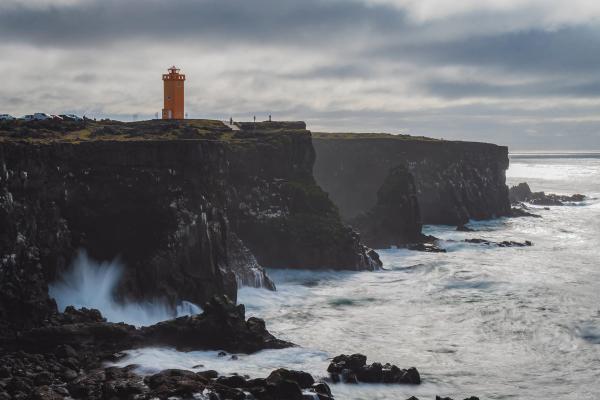
Kirkjufell & Kirkjufellsfoss
One of Iceland’s most photographed mountains, Kirkjufell rises like an arrowhead from the northern coastline of Snæfellsnes. The famous view is from the opposite side of the road, where you can capture a picture with the waterfall Kirkjufellsfoss in the foreground, tumbling over a small cliff while the cone-shaped Kirkjufell rises in the background. If you’re visiting between September and April, this is also one of the best spots in Iceland to see the northern lights.
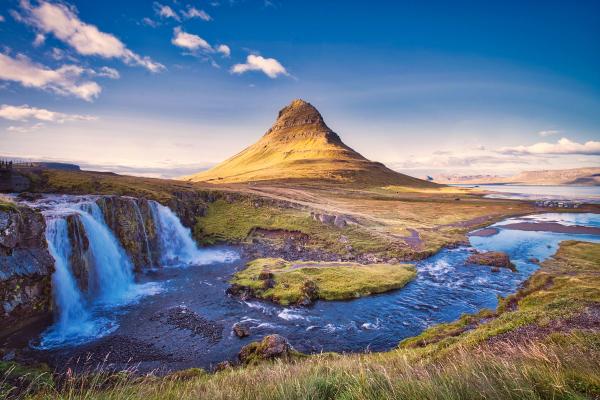
Grundarfoss
Tucked away just outside the other side of Grundarfjörður, Grundarfoss is one of Snæfellsnes’ hidden gems. This elegant waterfall plunges 230 feet (70 meters) over a sheer basalt cliff, framed by rugged green hills. A short hike leads to this hidden gem, often overlooked in favor of nearby Kirkjufell.
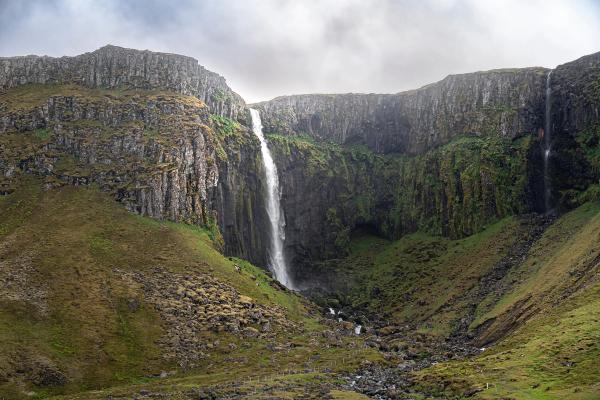
Stykkishólmur
The colorful heart of Snæfellsnes, Stykkishólmur is a charming harbor town known for its vibrant wooden houses, top-notch seafood, and sweeping views over Breiðafjörður Bay. The town’s picturesque harbor is the launching point for boat tours to the bay’s countless islands – you can also stick to land and explore the Súgandisey peninsula on the far side of the harbor, a large hill with panoramic views of the coastline and town below.

Berserkjahraun Lava Field
A surreal landscape of moss-covered lava formations, this lava field is tied to one of Iceland’s most dramatic sagas. Legend has it that two berserkers carved a path through the lava in an attempt to win a maiden’s hand in marriage. Regardless of the folklore, the eerie, otherworldly scenery makes for a fascinating visit.
Snæfellsnes truly is "Iceland in Miniature," packing all the country’s best features – volcanoes, glaciers, beaches, folklore, and wildlife – into one unforgettable destination.
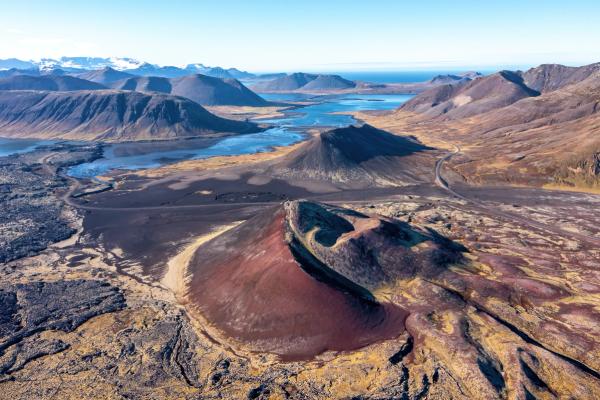
Hot Springs & Swimming Pools on the Snæfellsnes Peninsula
Are there hot springs on the Snæfellsnes Peninsula? While Snæfellsnes doesn’t have as many geothermal pools as the Reykjadalur or Mývatn regions, there are a few great spots to soak in naturally heated waters.
Lýsuhólslaug, a mineral-rich geothermal pool on the southern coast, is the best option for a soak. You’ll also find local swimming pools with hot tubs in Ólafsvík, Grundarfjörður, and Stykkishólmur. For those seeking a more remote experience, Landbrotalaug Hot Spring is a small hot spring near the peninsula’s eastern edge, big enough for just a couple of people.
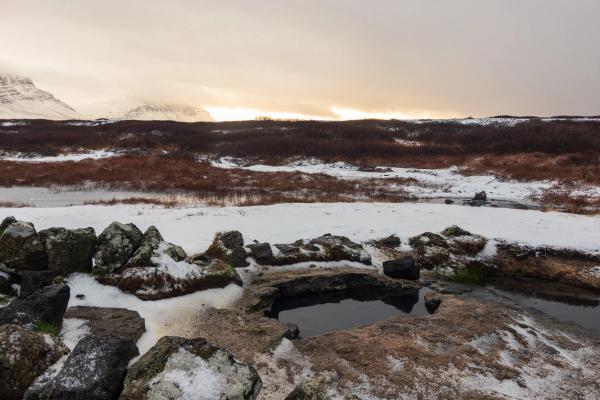
A Perfect 2-Day Snæfellsnes Peninsula Itinerary
While most people will careen around the peninsula in one day, those looking to explore the area in depth will do well to spend two or even three days there. We’ve put together what we think is the perfect 2-day Snæfellsnes Itinerary, hitting all the highlights while still leaving plenty of room for those unexpected discoveries that make road trips in Iceland so special.
Day 1: The South Coast & Snæfellsjökull National Park
The adventure kicks off with a 2.5-hour drive from Reykjavik to Snæfellsnes. Take Route 1 north to Borgarnes – your last major town for stocking up on supplies – then follow Route 54 west into the heart of the peninsula.
Morning:
- Ytri Tunga Beach – A rare golden-sand beach in Iceland, this spot is famous for grey seals sunbathing on the rocks just offshore.
- Búðakirkja – This striking black wooden church set against vast lava fields and distant mountains is one of Iceland’s most photogenic landmarks.
- Rauðfeldsgjá Gorge – Step into a narrow canyon carved deep into the mountainside. A short but adventurous scramble leads to a hidden waterfall inside.
Afternoon:
- Arnarstapi Cliffs – As the afternoon arrives, stop in Arnarstapi to admire the cliffs, including dramatic basalt formations and the Bárður Snæfellsás stone monument.
- Lóndrangar Cliffs – These towering basalt sea stacks, formed by ancient volcanic activity, look like the ruins of a medieval fortress rising from the ocean.
- Djúpalónssandur Beach & Dritvík – A haunting black-sand beach with rusted shipwreck remnants. Try lifting the fisherman’s stones to see if you could have worked on a Viking fishing boat.
Evening:
- Skarðsvík Beach – A hidden golden-sand beach surrounded by rugged black lava cliffs – a striking contrast to Iceland’s typical volcanic beaches.
- Svörtuloft Lighthouse (Optional Detour) – A bright orange lighthouse perched on dramatic cliffs at Snæfellsnes’ wild westernmost point.
- Overnight in Hellissandur or Rif – If camping, Hellissandur Campsite is one of the best in the country.
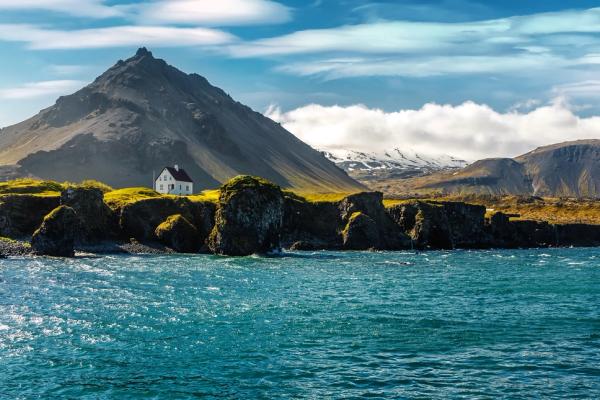
Day 2: The Northern Coast and Stykkishólmur
The northern side of Snæfellsnes has a different feel – quaint fishing villages, deep fjords, and stunning coastal panoramas.
Morning:
- Kirkjufell & Kirkjufellsfoss – Arrive at Iceland’s most photographed mountain first thing in the morning to avoid the crowds.
- Grundarfoss – Just outside Grundarfjörður, this 230-foot (70-meter) waterfall tumbles over sheer cliffs. Often overlooked, it’s a peaceful, uncrowded spot.
- Berserkjahraun Lava Field – Drive through this otherworldly lava field, tied to an Icelandic saga about two berserker warriors carving a path through the rocks.
Afternoon:
Stykkishólmur – The peninsula’s biggest town, known for its colorful wooden houses and seafood restaurants. Visit:
- Súgandisey Cliff – A short but steep climb up to panoramic fjord views.
- Library of Water – An unusual art installation featuring columns of melted glacial ice from across Iceland.
- Boat tours to Breiðafjörður Islands (Optional Extra) – Join a tour to spot puffins, seals, and sea cliffs.
Evening:
Landbrotalaug Hot Spring – If you’re heading back in the direction of Reykjavik, back on the southern edge of the peninsula make a stop at the Landbrotalaug hot spring – the later you arrive, the better chance you’ll have it to yourself.
Where to Stay on the Snæfellsnes Peninsula
Looking for the best hotels and campsites? We’ve got you covered. While there are no accommodations inside Snæfellsjökull National Park, plenty of great options can be found along the peninsula’s northern and southern coasts. Here’s where to stay for the best access to Snæfellsnes’ stunning landscapes.
The Southern Coast
The southern shore of Snæfellsnes is a vast, windswept stretch of farmland, with long, empty roads hugging the coast and only a handful of places to stay. For morning departures from Reykjavik, staying near the park’s edge offers the most dramatic scenery. The villages of Arnarstapi and Hellnar are the most popular bases in the region – Arnarstapi being slightly larger, with a couple of restaurants.
Just west of Arnarstapi, Oxl Guesthouse provides a simple but scenic stay, offering peaceful accommodations with sweeping views of the surrounding landscape. A short drive away, Hótel Búðir is the most famous hotel in the area, set in a lava field overlooking the Atlantic Ocean and Snæfellsjökull glacier.
If you’re leaving Reykjavik around lunch or in the afternoon, look for accommodation options further east along the coast. Lýsuhóll offers a rustic stay on a family-run horse farm. Nearby, Hotel Langaholt is another long-standing family-run hotel, a comfortable and welcoming base for exploring the peninsula.
For late departures from Reykjavik, there’s the Hótel Snæfellsnes, a comfortable and quiet countryside retreat. Also nearby is the new Miðhraun Lava Resort, offering a mix of well-furnished apartments, cottages, and rooms, along with a geothermal bath and restaurant.
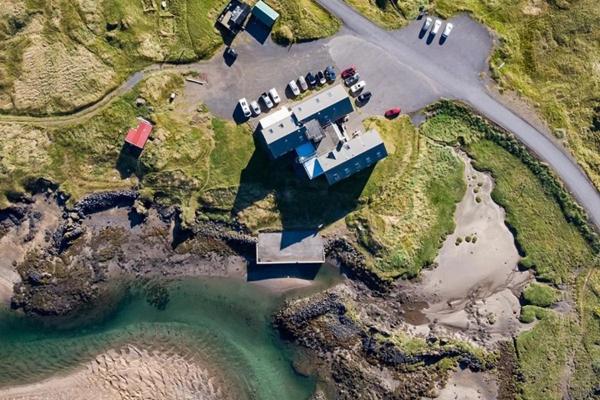
The Northern Coast
The northern side of Snæfellsnes has a different feel – larger fishing villages, dramatic fjord views, and a rugged coastline with more services than the quieter southern shore. After a day in Snæfellsjökull National Park, Hellissandur and Rif offer quiet retreats with stunning ocean sunsets.
A short drive east brings you to Ólafsvík, one of the peninsula’s oldest fishing villages. Here, you’ll find a few restaurants and accommodation options, including Hótel Ólafsvík and Við Hafið Guesthouse. Continuing along the road, Grundarfjörður is the best place to stay if you want to wake up with a view of Kirkjufell, Iceland’s most photographed mountain. The town and its surrounding countryside have a mix of hotels and guesthouses set against a striking backdrop of dramatic peaks and peninsulas.
The last major stop along the northern shore is Stykkishólmur, a picturesque port town and the gateway to the Westfjords. With a range of accommodations, it’s a logical base if you’re driving from Reykjavik and plan to explore the northern coast before looping down through the national park. In town, Hótel Egilsen is a top choice, a charming boutique hotel inside a restored historic building.
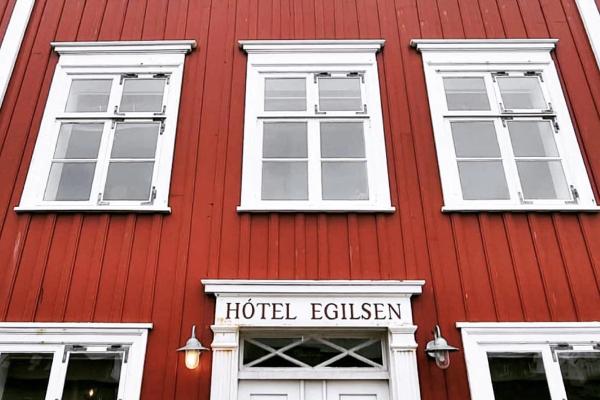
The Best Campsites on the Snæfellsnes Peninsula
Traveling with a campervan? Here are our top picks for where to park up for the night.
If you’re following the above itinerary and end up near the northern edge of the national park, then your best bet is the Hellissandur Campsite. The coastal location is beautiful, and the facilities are recently renovated.
Further along the northern coast, there’s also a great campsite in Ólafsvík. The campsites in the towns of Grundarfjörður and Stykkishólmur aren’t as nice, with limited services, but make up for it with easy access to Kirkjufell before the crowds arrive or as a good base for catching the ferry to the Westfjords the following day.
There’s also a campsite at Arnarstapi on the southern edge of the national park, and at a few other locations along the way.
When to Visit Snæfellsnes
The best time to visit the Snæfellsnes Peninsula is in April and May, when the crowds are still low, but the days are long, and the weather is improving. This shoulder season offers a perfect balance of clear roads, beautiful landscapes, and extended daylight hours for exploring. However, each season has its own charm – here’s what to expect throughout the year.
Spring in Snæfellsnes (March to May)
Spring in Snæfellsnes is a great time to visit. Snow still caps the mountains, but the coastal roads remain clear enough for easy driving. Temperatures range from 30°F to 46°F (-1°C to 8°C), and by May, daylight stretches to 18 hours, giving you plenty of time to explore. Spring also means fewer crowds, making popular spots like Kirkjufell and Arnarstapi feel more peaceful.
Summer (June to August)
Summer brings mild temperatures (50°F to 59°F / 10°C to 15°C) and nearly 24-hour daylight, making it the most popular time to visit. Expect peak-season crowds, busier hotels and campsites, and higher rental prices. But you can always take advantage of the midnight sun and explore when most tourists are asleep.
Autumn (September to November)
Autumn is seriously underrated. With temperatures cooling (36°F to 50°F / 2°C to 10°C), the moss-covered lava fields turn vibrant shades of red and gold. The darker nights also increase your chances of seeing the northern lights, especially if you’re camping in remote areas. Like Spring, it’s a fantastic time to explore.
Winter (November to March)
Winter turns Snæfellsnes into a snowy wonderland, but it requires preparation. Temperatures range from 28°F to 37°F (-2°C to 3°C), and daylight is limited to 4-5 hours in December and January. A 4x4 vehicle is recommended if you plan on exploring beyond the main roads. If you’re looking for budget-friendly travel, February and March often have the best rates before the spring shoulder season kicks in.
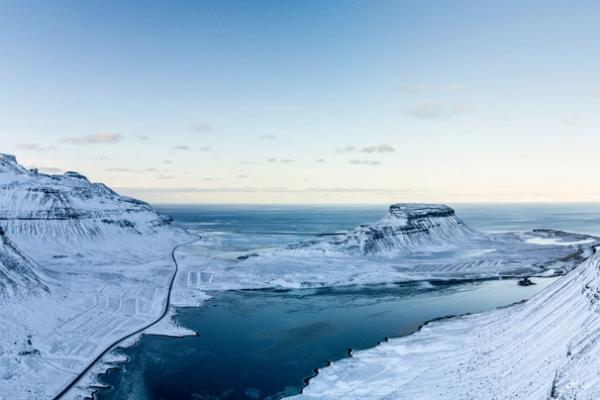
Road Trips on the Snæfellsnes Peninsula
Snæfellsnes packs Iceland’s best features – volcanoes, glaciers, waterfalls, and black-sand beaches – into one easily explorable region. Unlike the vast stretches of the Ring Road, here you can take your time, revisit favorite spots, and enjoy the freedom of a flexible itinerary.
Each season brings something special – summer’s endless daylight, autumn’s golden landscapes, and winter’s northern lights over snowy peaks. Whenever you visit, Snæfellsnes delivers – breathtaking landscapes, no rigid schedules, and fewer crowds than Iceland’s busiest routes.
Our best advice? Stay flexible. Iceland’s weather is unpredictable, but that’s part of the adventure. Whether you're soaking in a secret hot spring or standing beneath Kirkjufell at golden hour, Snæfellsnes never disappoints.

